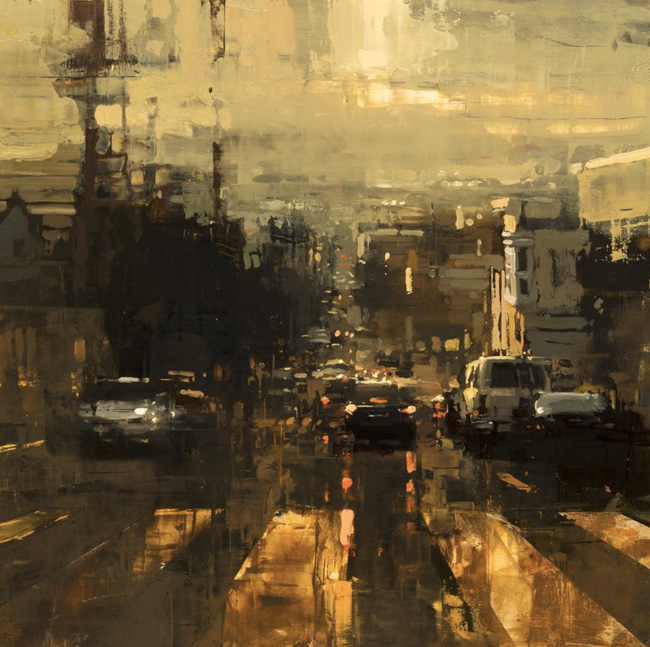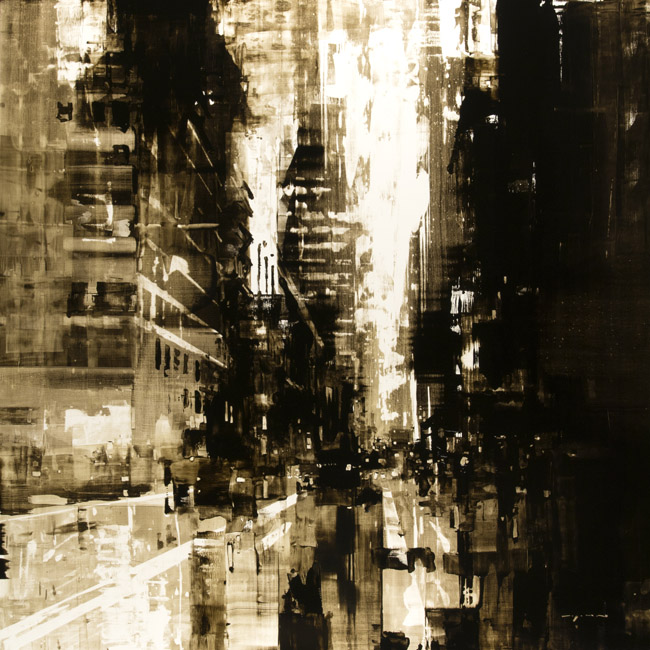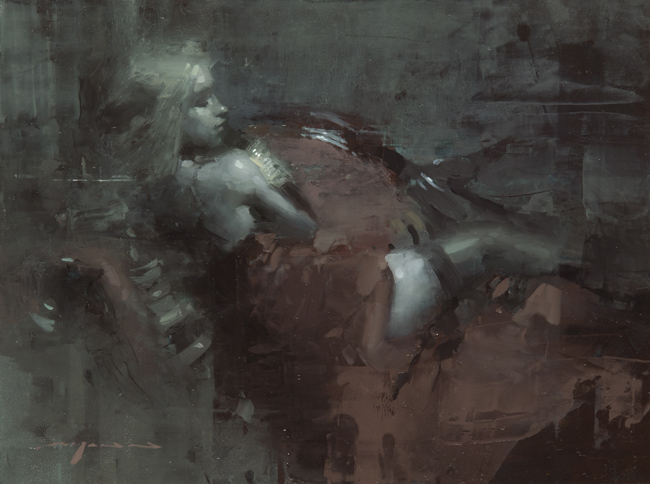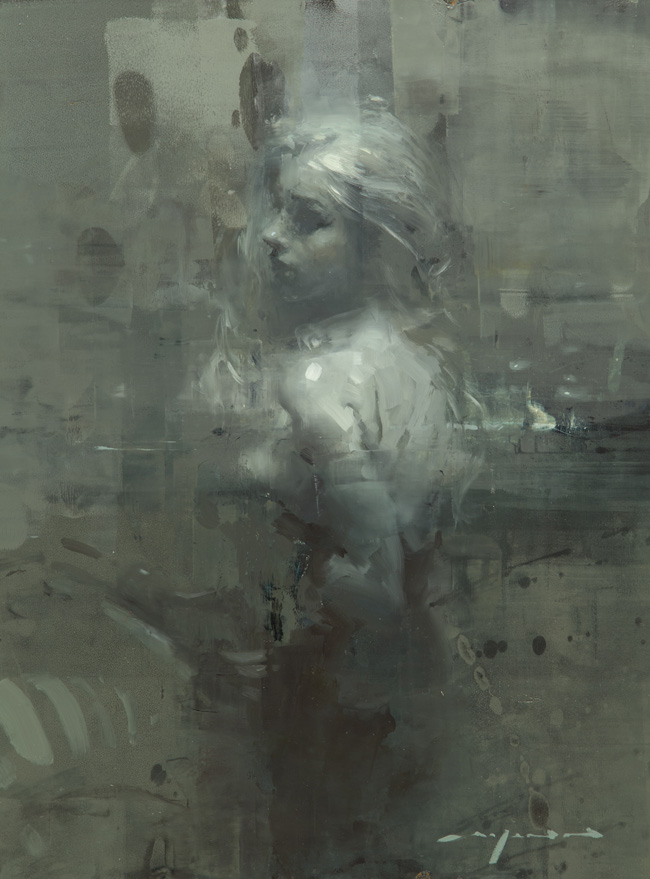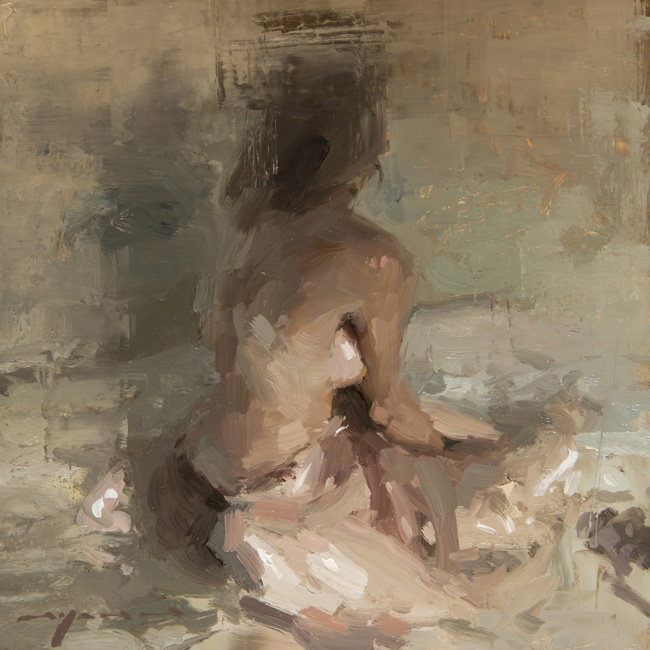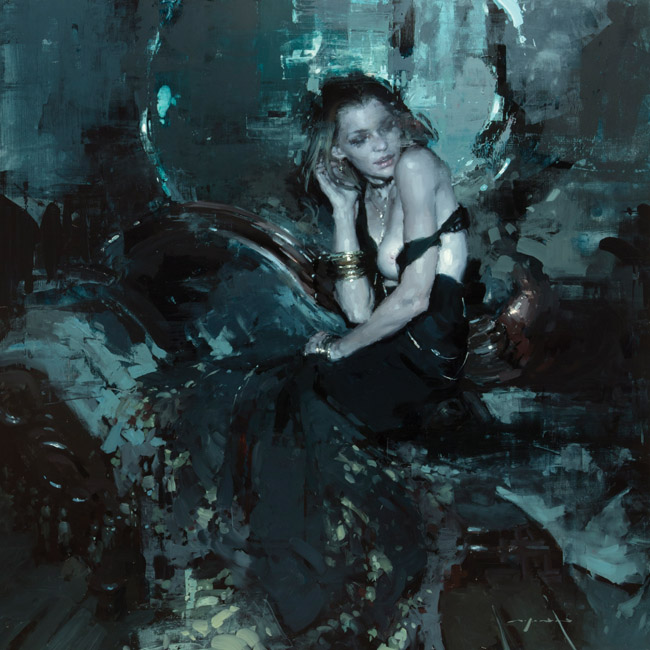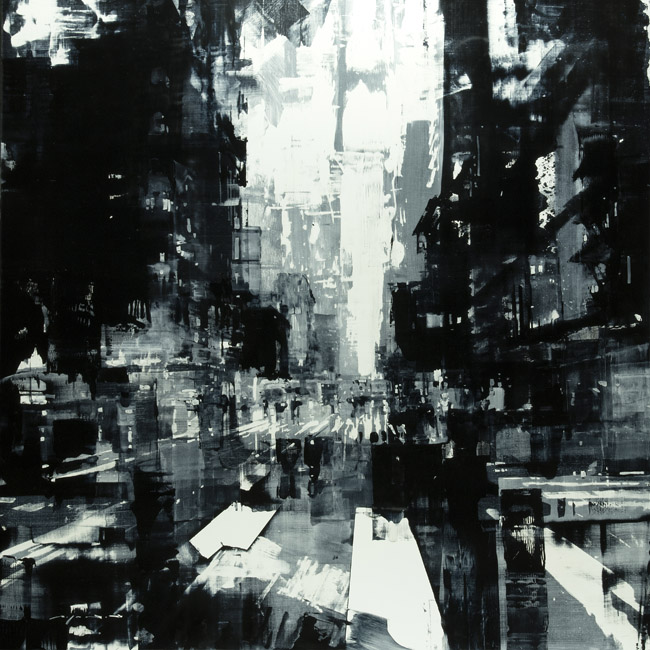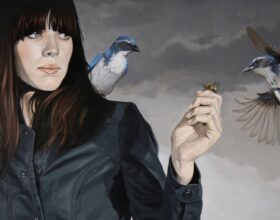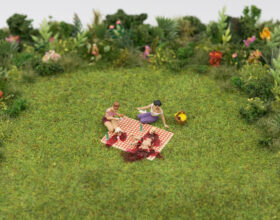 Vigour and seduction… he paints with an aggressive and dynamic mark and yet, Jeremy Mann invites us to see his world through the quietly brooding melancholia of a wet evening street and the seductive glance of a female model.
Vigour and seduction… he paints with an aggressive and dynamic mark and yet, Jeremy Mann invites us to see his world through the quietly brooding melancholia of a wet evening street and the seductive glance of a female model.
In 2016, I was in San Francisco and indeed lucky to see Jeremy Mann’s solo exhibition. I had seen his work online and in Beautiful Bizarre Magazine issue 014, but nothing prepared me for the experience of seeing his work in the flesh. The paintings were displayed in a dark space and the points of light within those canvases leaped out as if the canvases were lit up from behind. The cityscapes took my breath away, and the women were sensuous and haunting. It was an unforgettable experience. When I was offered the unexpected opportunity of interviewing Jeremy about his upcoming exhibition at Evoke and about his work and practice I jumped at it. He is a deeply thoughtful artist and one who speaks from a place of countless hours of experiment and work, and a depth of knowledge, skill and understanding that commands our respect.
Jeremy Mann: Experimentations, Process and Emotions
Opening Reception:
Friday, April 28, 2017 | 5- 7pm
Exhibition Dates:
April 28- May 20, 2017
EVOKE Contemporary
For press and sales inquiries, contact the gallery directly: 505.995.9902
ke@evokecontemporary.com or ev@evokecontemporary.com
Press Release:
Experimental foundations, intentional artistic processes and opposing poetic emotions make up Jeremy Mann’s latest body of sensuous portraits and moody cityscapes, debuting this spring at EVOKE Contemporary. The San Francisco artist’s seemingly distinct subject matter is tied by underlying emotive forces, allowing the viewer to see past the subject and experience the poetic, yet intense emotional impact that is the essence of Mann’s work and the captivating draw for his global following. Experimentations, Process and Emotions opens April 28th with an artist reception, and will be on display through May 20th.
Interview
Your imagery moves between the cityscape and the female figure, and yet these are very different subjects. Can you tell us a little about the fascination these subjects hold for you. What, if anything connects them for you as inspiration? What qualities or physical features do you look for in a model or a scene?
I desire more to be an artist, than to limit myself just to painting. As such, just a cityscape painter, I wanted to be a painter of all things. What drove me to pursue a master’s program was not only a forced 3 year necessary indulgence in study, but also because, in the limbo after my BFA, I realized I wouldn’t depict certain subject matter in my paintings because I couldn’t paint it, not because it was omitted by choice. That was the impetus for my desire to paint everything. Each subject has its own harmonies, which work well with it, and not with others, you wouldn’t necessarily want to see a cityscape painted with all soft round forms and silk, it has hard edges, is furious and war torn, grand in scale and aggressive in balanced atmosphere of shapes… (well, now that I say it, a soft silky cityscape would be pretty unique… just goes to show there are no rules, only the ones we individually design to keep ourselves sane while creating.) The cityscapes are where I get out aggression and exuberance, jumping around, loud music, dancing, slinging paint, punching the panel, spitting at it, and all in a whirlwind built from the foundations of art; of shape, value, pattern, balance, line, perspective, edges, etc. It is the heavy metal concert to the ballet of the figures. There in figures, in the paintings of women, I find a comfort, a softness, a delicate touch and gentle glide of wet paint. The emotion and implied stories surrounding these women allows me a surface to exude more psychological and personal stories. The atmosphere they exist in can be harsh as well, with strong, forceful marks crossing soft bodies, pushing and pulling at limbs and lace, bathed in an aura of light. My mind is not a single chapter, there’s too many volumes to limit myself to just one idea like a craftsman. The plein air landscapes I create are kept mostly for myself, because they are my memories, I remember every moment of the day, the café in Hungary I sat at, the light, the people, sounds and smells, everything captured in a little moment from life on a travelling panel. They are my personal snapshots in my photo diary, which nobody will fully absorb. In everything I paint, the study of awareness and how to depict it in a way which pleases me arches over all subject matter, but the individual subjects have their own doors to different windows, like different instruments in an oeuvre symphony.
When I wander through the rat race and storm of a city on a photo shoot, I’m scanning reality for those elements of art I see when I paint in the studio. It’s like when you use the Fibonacci sequence or the golden section in your painting composition and then also become aware of its use in pinecones, sunflowers and seashells. The balance and harmony of shapes I create in my cityscapes is actually there in real life, but unless you study it and know it, you won’t see it. Those are all the people who walk through the city on their way to work staring at their cell phones. They won’t understand the deeper meaning behind the alignments of buildings, perspective, cars, people clumps, lights, reflections, weight of buildings, shapes and balance all aligning for one split second, because they haven’t studied it. Painting is the study of beauty, and in order to realize true beauty in all its forms in nature, one must study art. This is not a dream or wish, its fact and truth. Mucha was one of the most recent true advocates for this, Whistler before him, the Greeks who upheld the study of art and beauty in direct correlation with mathematics and science. These days, people have allowed taste and distraction to interfere with the arts, and the true reason for its purpose and why artists create, is lost on them. And then, they all call it “magic.” You don’t call landing robots on mars “magic” but the fact that I see and depict harmony in chaos is? It actually makes me sad. And is one of the reasons I stay in my home more and more.
Therein lies the reason for the figure paintings, it gives me full control of an opera stage with characters, lighting, sets and scenes to create the world of my mind, the world of my imagination. With harmony of colors, and balances of forms across a beautiful creature, the nature of which eludes most all men and women. Love is a thing that permeates all forms of art since the first bison drawing on a wall. The love for that wild beast, its strength, grace and mystery, and the sustenance it gives to the artist. Same with my paintings of women.
I felt, looking at your body of work, that over time it has become more and more ‘deconstructed’, the brushstrokes are looser, the backgrounds dissolved, almost pared down to the contrasts between light and shadow, and this is particularly evident in the works on show at Evoke. I have always felt that this comes as an artist becomes more experienced, skilled and has a deep knowledge and affinity with their materials and subject matter. So it was of particular interest to hear you talk about this is the 2016 Loic Zimmermann documentary about you. “…I now know the minimal information to get that idea across, and bring, that is, ten or fifteen years of study into a two minute mark… like that’s the rehearsal, rehearsal…” Can you talk a little bit about that process of developing a language of ‘minimal mark making’, which may look effortless to some, but comes of years of artistic practice.
Indeed, appears effortless because of the countless hours of study, practice, experimentation, and a development of awareness. I’m in no way the first person to believe in this. Whistler won a famous lawsuit with the same ideals. Every single Olympian knows the value of practice. Every single musician knows the true effects of endless hours of study and practice. Those who don’t, simply call it talent, or magic again, or “born-with-it.” Physiologically, it’s actually a mental safety button that our brains create in order to keep us alive in situations beyond our comprehension. When something we don’t fully understand is occurring right in front of us, we subconsciously label it as something otherworldly, because it gives our brain comfort to label it as simply magical so that we can move on looking for food and shelter to survive. If we were actually confronted with the fact that we are alone on a little rock with water floating in the most vast expanse of nothingness with black holes and other dimensions that has existed for trillions of billions of years, your brain would implode, and that doesn’t help you eat salad and brush your teeth. Anyway, stick with me, that does all apply to art, in the sense that the more I draw, the more I paint, the more experiment with tools, applications, processes, not only in creating the paintings, but arriving to their inspiration and reference material, the more learn to see with a deeper part of my mind. Beginning artists create hard edges to round forms, they use two-dimensional outlines to describe three-dimensional forms, and those who do it poorly, well, the viewers don’t fully enjoy their art, because it doesn’t depict the reality their deeper conscious knows. The same as unbalanced compositions, eyes or headlights in the wrong place, garish use of color or anything else that doesn’t appear as part of something our subconscious brain understands it to be in the natural or the psychological world. So, the more you train yourself in the arts, by drawing constantly, painting constantly, questioning why I have to use a brush, questioning why I need to do it this way, that way, the “what if I try this” and the resulting “no, that was stupid, don’t do that again” or the following next day’s “wait, no, I do like this. Yes, it’s stupid now, but I’m onto something.”
Those are how an artist becomes the detective into the true world of nature, of people, of all things around them, and why their lives are so enriched because what we know in art, we now also see in the world. People must not see art as attempts to tangibly depict beauty in all its forms, good or evil, but as the tangible study of beauty, in order to fully experience it in our lives. This is why people are drawn to museums, part of their vestigial mind still desires to study our manifestations of beauty, in the hopes they will live it in their lives.
You use a number of processes or techniques in the development of your works, some of which are quite deconstructive in themselves. How would you describe the balance of your planned intent and necessary control over these processes to your intuitive response to the marks you make with these processes as a work develops?
I’ve always had a personal issue with brushes and canvas. I hate those two words, even more so together. Yet they are, without any question or doubt from the crowd, the first things people pick up and call themselves artist. I never truly and fully enjoyed the marks those things make; it was like I was writing stories but in someone else’s old shitty handwriting. When I opened myself up and discovered not only how to make marks which resonate personally with me, but also the importance of that uniqueness, I unveiled an entire world of possibilities which continues to this day, and will forever keep evolving, hence the title for the show at Evoke. One of my favorite valentine’s days was spent at the hardware store with the giddy little intent of running down the aisles in search of strange new objects to make paintings with. Who was to say that the marks I was making with my original new tools are the paramount poetry of my painting language? What If I STILL haven’t found it!? And so on and on the practice goes, find a new way to create, judge if it’s good or bad based only on my own values, then toss it or perfect it. The constant practice, study, and evolution is the perfecting of my painting language, so that, when I set the stage of my studio just right, with the right music, the right light, the right state of mind, the state of my personal life, and the clear mental state to perform, I free myself to simply let loose. If I had to contemplate about color mixing, brush application, and all the other menial things involved in, but not the main point of, creating art, my mind would burst. You don’t truly look at every single word in a sentence that you are reading, you really only read the first and last letters and your brain puts the word into your mind.
Watch, read this fast: (sentence meant to appear this way)
I cnduo’t bvleiee taht I culod aulaclty uesdtannrd waht I was rdnaieg. Unisg the icndeblire pweor of the hmuan mnid, aocdcrnig to rseecrah at Cmabrigde Uinervtisy, it dseno’t mttaer in waht oderr the lterets in a wrod are, the olny irpoamtnt tihng is taht the frsit and lsat ltteer be in the rhgit pclae.
That’s what painting is, the medium is just different, and I spend 99% of my waking life studying the “letters” which make the poetry of painting come alive.
In 2016, I was lucky enough to be in San Francisco and see your solo show. What struck me most forcefully about the works on show was the use of light. It took my breath away, seemingly to radiate out of various points in the compositions, such as a reflection on a rainy pavement, a neon light, a sunset, or the shimmer of a gown or jewel. It was almost as if parts of the paintings were lit from behind. Tell us about the use of light in your works and its importance to you and the paintings. Can you describe how you achieve such breathtaking effects?
Oh man, light is a wonderful tool! It is rarely ever studied to its truest form in any art school or afterwards, but if it the light is wrong in any painting you can’t fully grasp why the painting looks bad or off, it just feels abnormal. With enough study you could point out that a shadow doesn’t fall in the right spot, that surface should have a reflection, the light in the distance is too… too… too something. I realized long ago, what a powerful tool the perfection of perceiving light can be. It superseded everything we see in our life, it is the reason why we can see in the first place, and it has an endless amount of attributes for study!
When I was highly interested in lucid dreaming, I kept hundreds of pages of dream journals and deciphered the reason why I can become self-aware of a dream state is because the light in my dreams would never have an exact, identifiable source. I met an artist in Florence once who actually used the rational effects of light in irrational ways by creating paintings where the reference was only his memory of the scene, and so by twisting the laws of light with intelligence, he created spaces that seemed to both exist and not exist at the same time. So when I am painting, much of the images I create have an underlying structure of light qualities, which create the “life” in the painting itself. This is something you only can truly harness if you’ve spent hours, days, years just looking… just looking at the world around you, in dusk, at dawn, standing in the storm instead of hiding from it, (it’s just water, grow up and stand blissfully in the turmoil!), wandering dappled forest paths, swimming with your eyes open in the sea, being aware of why you know where you are. And the more I understand light, the more I implement control of it (and purposeful lack of control) when setting up not only the scenes for my paintings, but also just the scene in the house I wander around in daily. The study of these qualities of art must be the principle quality in my life, and therefore, I never turn it off.
You use antique cameras, and Polaroid’s to photograph your subjects. Some of these were included in that exhibition. What qualities do these cameras give you in terms of the images they produce and how do you interpret those images in your paintings?
Just because something is new and technologically advanced, doesn’t make it superior for your own needs. This silly obsession with digital imagery is death for artists in my opinion. I don’t believe that people honestly want to see paintings that mimic hyperreal photographs, we have photographs for that, and all that really does is exhibit a very astute and diligent craftsman who can only depict the way a machine documents the world with a crass degree. I have great admiration for those who do paint like that, it takes a high amount of skill and craftsmanship to create, and that is the sign of a good worker. But I only have one life and I should probably stick to my own guts, therefore I feel that people want to look at paintings that make them feel something, in order to connect to something deeper, a conversation the artist who “sees and knows” is trying to express to their fellow people they share life on earth with. They don’t want to be distracted by the craft of hours of labor in order to reproduce something, like seeing stagehands and cameras in a film, you’ll lose the effect of the intangible wonder of the story. When I began to shoot with the antique film cameras, it was because of their quality of memory we tie with it. The older photographs get, the stronger the quality of memory becomes, and until eventually, it takes you back in time, to moments long before you were even alive. You see printed digital photographs from last year and reminisce; you see actual printed photos from film of when you were a teenager and think those days are lost. You see a Polaroid from your parents first date and you can’t believe it. Wet plate photographs from Victorian London, Italy, or of the struggle in the early American west and you are transported to different eras. And for me, all the way back to the first experiment with photography, the original first ever photograph, an image of rooftops over Burgundy in France shot in 1826 by Joseph Nicéphore Niépce, an image in my opinion to be one of the most beautiful things I’ve ever seen. Its defects, its haze, it is reality in a dream, and it’s all captured on a two dimensional object that now exists, and creates, deep within ourselves, an awareness of time, the past, and life. These are things I’ve always wanted to not only create in my paintings, but also to attempt to capture on film myself. So I began to dissect the cameras, build my own out of wine and cigar boxes and parts from Polaroid cameras, allowing for imperfections to be an equal participant with me. Dissolving the images in chemicals in a dark room to go even further in its deconstruction, back, back in time, by moving forward in exploration of capturing my imagery through photography. And then I reach a point, my goal from the beginning, where the actual reference is now a piece of artwork itself, and as I set myself upon that studio stage ready to paint it, I am already beginning at %100 affinity with my reference My reference is, in effect, already beyond me, and my springboard for capturing those qualities of life I was looking to paint.
To this day, it is constantly continuing. I created my (currently) favorite lens from binocular parts, toilet paper tubes, and duct tape, which can be mounted on a digital film camera. It’s hilarious. Like shooting high-def through garbage, and I love all the effects of it, there is no need for any incapable digital filters, it not only depicts how I see, but how I exist as a painter, a viewer of life. And this was all inspired by an old Czech photographer, whose own life is work of art itself, a discovery made in Loic’s library when visiting him in LA. I’m sure many people find the look of the films from this lens annoying or unimpressive, but for me, it’s quintessential to the rest. I’ve begun to make short films, one of which I shot with the lens and depicts the process of how I get my references, from building the cameras, taking the shots with the woman, developing and all the little secrets in that film are actually explicit links to how and why I paint. It was my answer to the annoying pervasiveness of “varnish porn,” time-lapse painting, and instructional demos running rampant across the art world. Of course, it’s not an easy statement for many to grasp, so it simply falls to the wayside, but for me, my new inspiration for any and all things I create, is currently evolving from this.
Earlier I touched on the documentary ‘A Solitary Mann’ that was made about you, in 2016 by Don’t Come Knocking Pictures. Can you tell us a little about the film and how it came to be made? I know artists can be quite private about their studio so how did feel about the intrusive nature of having others in the room and being watched. When you saw the final edited film for the first time, did anything surprise you about your art practice or works that hadn’t occurred to you?
Loic first saw me painting at a workshop hosted by friends in Los Angeles. He had been working in the film industry for quite some time at that point, and was also beginning to shoot his own short films and documentaries, and all this alongside a skilled and amazing life as a fine artist and illustrator. He’s another who knows that artists cannot be pigeon holed by a subject or a medium. A year or so later we met at the Trojan Horse was a Unicorn workshop in Portugal, a massive conglomeration of artists and educators. He approached me to do a film, and after seeing and knowing him to be a true artist, I of course agreed. Afterwards, I reflected upon my hasty decision and panicked. I never let anyone into my studio to see me paint, it’s the most personal place and mindset I can be in. However, I feel very strongly that the words of an artist are just as important as their physical creations, and with the ability to exist through Loic’s film as an artist who also has a brain and heart instead of just a picture maker, was to be an important step for me. Eventually, when the next books I create start coming out, they will also be filled with as much writing as I can muster, to even further the message of my creating.
Loic has become a good friend, he lived with me and followed me everywhere for 4 days, which at that point in my life, was longer than anyone had been allowed around me in a consistent manner, for over 8 years. Our mutual respect and agreement on many things made it a lot easier. He wasn’t out to create another misleading instructional documentary film, he wanted something deeper, his art and my art twirling in one, and that’s exactly what I think he came out with. It was difficult, but I learned very quickly to just be honest, because what’s the point of doing anything but. The four days passed. Literally hundreds of hours followed in the months that man spent editing and tweaking the timetable, montage, shots, audio, and video in an endless and insomniatic determination to create to his best. All this while holding a full time job during the day as well.
He sent it to me late one afternoon. I walked in silence to the nearest grocery store for a bottle of good wine to suffice for dinner, and I believe I watched the film in my studio four times in a row. I still can’t describe how weird it is for me to see. How am I supposed to describe what I felt sitting in a room where I paint, watching a film about me in that room painting the thing that is now behind me fully painted? Like a psychological hall of mirrors, embarrassing and empowering at the same time. Incredibly well done by Loic, and I hope inspirational for anyone who watches it.
View Jeremy’s photography and short films + enjoy The documentary by Loic Zimmermann
Experimentations, Process and Emotions is the title of your new exhibition at Evoke Contemporary. Can you explain the title of the show, and what it represents about these works, in particular? Is there a particular emphasis in this new body of work? Do have a piece in the show you feel most invested in, or particularly pleased with, or is there one that was more difficult to resolve?
Well, mostly I hope, and can only assume, that the title of the show won’t really directly correlate with the paintings that are hanging, because this will lead to the discussion of their creation, and that is the real point of the show. What is hanging on the walls, and what I always love about visiting paintings in museums, is that they are the physical resulting aftermath of the war and love an artist went through to create them, and they stand like relics on the wall, untouchable and wrought with sacred history. But the things I described here in this interview are just a small amount of the guts and truth behind the physical form of the paintings themselves. What I go through in my daily life, the things I see, feel, experience, study, explore and experiment are the actual processes used to create the art. I feel that galleries these days have had their name tarnished by not only terrible actions committed against artists by false galleries, but also have had their worth diminished by galleries which pander to the unknowledgeable public in order to just make a profit. It’s a natural evolution, as the gallery ideals haven’t had a moment to recuperate during the last decade’s exponential expanse of all things digital including digital lives lived through social medias. The true gallery ideal is very important for the future existence of artists, and the continued survival of artists is also unquantifiable paramount for the survival of culture and nature. (You must think beyond trees and mountains when one says “nature”.) And in my efforts to support this ideal, I’ve created this next show of mine to not only display the results of my experimentations and creations, but to also open to door for discovery and discussion about the real truths behind the purpose of art in our lives. I believe we are planning to do an artist talk, as I am highly against the idea of doing demos for the public, it isn’t truly enriching for them to watch from the shadows behind the artists back, but it’s more important that we get to sit down and delve into the constructs, reasoning, purpose, and knowledge that an artist has to say, in a comfortable environment, and of course (I’m hoping!) with good wine. :)


